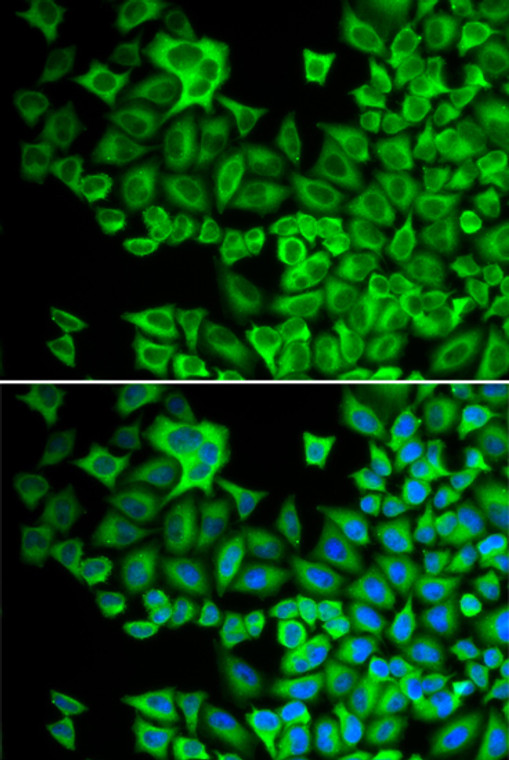| Host: |
Rabbit |
| Applications: |
WB/IF/ICC/ELISA |
| Reactivity: |
Human |
| Note: |
STRICTLY FOR FURTHER SCIENTIFIC RESEARCH USE ONLY (RUO). MUST NOT TO BE USED IN DIAGNOSTIC OR THERAPEUTIC APPLICATIONS. |
| Clonality: |
Polyclonal |
| Conjugation: |
Unconjugated |
| Isotype: |
IgG |
| Formulation: |
PBS with 0.02% Sodium Azide, 50% Glycerol, pH 7.3. |
| Purification: |
Affinity purification |
| Concentration: |
Lot specific |
| Dilution Range: |
WB:1:500-1:2000IF/ICC:1:50-1:200ELISA:Recommended starting concentration is 1 Mu g/mL. Please optimize the concentration based on your specific assay requirements. |
| Storage Instruction: |
Store at-20°C for up to 1 year from the date of receipt, and avoid repeat freeze-thaw cycles. |
| Gene Symbol: |
HCK |
| Gene ID: |
3055 |
| Uniprot ID: |
HCK_HUMAN |
| Immunogen Region: |
1-220 |
| Specificity: |
Recombinant fusion protein containing a sequence corresponding to amino acids 1-220 of human HCK (NP_001165600.1). |
| Immunogen Sequence: |
MGCMKSKFLQVGGNTFSKTE TSASPHCPVYVPDPTSTIKP GPNSHNSNTPGIREAGSEDI IVVALYDYEAIHHEDLSFQK GDQMVVLEESGEWWKARSLA TRKEGYIPSNYVARVDSLET EEWFFKGISRKDAERQLLAP GNMLGSFMIRDSETTKGSYS LSVRDYDPRQGDTVKHYKIR TLDNGGFYISPRSTFSTLQE LVDHYKKGNDGLCQKLSVPC |
| Tissue Specificity | Detected in monocytes and neutrophils (at protein level). Expressed predominantly in cells of the myeloid and B-lymphoid lineages. Highly expressed in granulocytes. Detected in tonsil. |
| Post Translational Modifications | Phosphorylated on several tyrosine residues. Autophosphorylated. Becomes rapidly phosphorylated upon activation of the immunoglobulin receptors FCGR1A and FCGR2A. Phosphorylation by the BCR-ABL fusion protein mediates activation of HCK. Phosphorylation at Tyr-411 increases kinase activity. Phosphorylation at Tyr-522 inhibits kinase activity. Kinase activity is not required for phosphorylation at Tyr-522, suggesting that this site is a target of other kinases. Ubiquitinated by CBL, leading to its degradation via the proteasome. Isoform 2 palmitoylation at position 2 requires prior myristoylation. Palmitoylation at position 3 is required for caveolar localization of isoform 2. |
| Function | Non-receptor tyrosine-protein kinase found in hematopoietic cells that transmits signals from cell surface receptors and plays an important role in the regulation of innate immune responses, including neutrophil, monocyte, macrophage and mast cell functions, phagocytosis, cell survival and proliferation, cell adhesion and migration. Acts downstream of receptors that bind the Fc region of immunoglobulins, such as FCGR1A and FCGR2A, but also CSF3R, PLAUR, the receptors for IFNG, IL2, IL6 and IL8, and integrins, such as ITGB1 and ITGB2. During the phagocytic process, mediates mobilization of secretory lysosomes, degranulation, and activation of NADPH oxidase to bring about the respiratory burst. Plays a role in the release of inflammatory molecules. Promotes reorganization of the actin cytoskeleton and actin polymerization, formation of podosomes and cell protrusions. Inhibits TP73-mediated transcription activation and TP73-mediated apoptosis. Phosphorylates CBL in response to activation of immunoglobulin gamma Fc region receptors. Phosphorylates ADAM15, BCR, ELMO1, FCGR2A, GAB1, GAB2, RAPGEF1, STAT5B, TP73, VAV1 and WAS. |
| Protein Name | Tyrosine-Protein Kinase HckHematopoietic Cell KinaseHemopoietic Cell KinaseP59-Hck/P60-HckP59hckP61hck |
| Database Links | Reactome: R-HSA-164944Reactome: R-HSA-2029481Reactome: R-HSA-912631Reactome: R-HSA-9664323Reactome: R-HSA-9664422Reactome: R-HSA-9674555Reactome: R-HSA-9680350Reactome: R-HSA-9705462Reactome: R-HSA-9706374 |
| Cellular Localisation | Isoform 1: LysosomeMembraneLipid-AnchorCell ProjectionPodosome MembraneCytoplasmCytosolAssociated With Specialized Secretory Lysosomes Called Azurophil GranulesAt Least Half Of This Isoform Is Found In The CytoplasmSome Of This Fraction Is MyristoylatedIsoform 2: Cell MembraneCaveolaCell JunctionFocal AdhesionCytoskeletonGolgi ApparatusCytoplasmic VesicleLysosomeNucleus20% Of This Isoform Is Associated With CaveolaeLocalization At The Cell Membrane And At Caveolae Requires Palmitoylation At Cys-3Colocalizes With The Actin Cytoskeleton At Focal AdhesionsSecretory Vesicle |
| Alternative Antibody Names | Anti-Tyrosine-Protein Kinase Hck antibodyAnti-Hematopoietic Cell Kinase antibodyAnti-Hemopoietic Cell Kinase antibodyAnti-P59-Hck/P60-Hck antibodyAnti-P59hck antibodyAnti-P61hck antibodyAnti-HCK antibody |
Information sourced from Uniprot.org
12 months for antibodies. 6 months for ELISA Kits. Please see website T&Cs for further guidance






